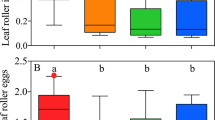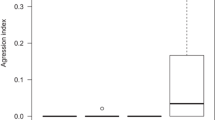Abstract
Ant-related oviposition in facultatively myrmecophilous lycaenid butterflies is common, but not universal. In fact, our knowledge of ant-related oviposition in lycaenids is based on some common species (e.g., Rekoa marius, Allosmaitia strophius, Parrhasius polibetes), which limits generalizations about these systems. In this study, we experimentally investigated whether the oviposition pattern of the florivorous lycaenid Leptotes cassius was influenced by the presence of Camponotus ants and whether larvae were attended, rather than attacked, by ants. This might be evidence of myrmecophily. Both L. cassius and Camponotus ants occur on Bionia coriacea, an extrafloral nectaried legume shrub that grows in the Brazilian cerrado. Plants were randomly assigned to ant-present and ant-excluded treatments and were observed twice throughout the short reproductive season. Larvae of L. cassius were tended by ants, whose attendance was characterized by active antennation on the last body segments of the caterpillars. Therefore, Camponotus can be considered a partner of L. cassius. Lycaenid abundance was on average 1.9- and 1.21-fold higher in plants with ants in each sampling period, respectively, indicating a tendency of L. cassius to occur in plants with ants. Nonetheless, results were not statistically significant, suggesting that in this case ants are not a major cue for lycaenid oviposition. In many ant–lycaenid mutualisms, butterfly immatures benefit from reduced parasitism rates. However, no L. cassius immature, regardless of ant presence or absence, was parasitized. Furthermore, larvae may occur inside flower buds that may provide protection from natural enemies; thus, ants may not be required for immature protection.

Similar content being viewed by others
References
Alves-Silva E, Del-Claro K (2014) Fire triggers the activity of extrafloral nectaries, but ants fail to protect the plant against herbivores in a neotropical savanna. Arthropod Plant Interact 8:233–240. https://doi.org/10.1007/s11829-014-9301-8
Alves-Silva E, Bächtold A, Barônio GJ, Del-Claro K (2013) Influence of Camponotus blandus (Formicinae) and flower buds on the occurrence of Parrhasius polibetes (Lepidoptera: Lycaenidae) in Banisteriopsis malifolia (Malpighiaceae). Sociobiology 60:30–34. https://doi.org/10.13102/sociobiology.v60i1.30-34
Anjos D, Alves-Silva E, Ribeiro SP (2016) Do fire and seasonality affect the establishment and colonisation of litter arthropods? J Insect Conserv 20:653–661. https://doi.org/10.1007/s10841-016-9896-4
Axén AH, Leimar O, Hoffman V (1996) Signalling in a mutualistic interaction. Anim Behav 52:321–333. https://doi.org/10.1006/anbe.1996.0178
Bächtold A (2014) A comunidade de licenídeos de uma área de cerrado: especificidade de dieta, interações ecológicas e seleção de plantas hospedeiras. Thesis, University of São Paulo
Bächtold A, Alves-Silva E (2013) Behavioral strategy of a lycaenid (Lepidoptera) caterpillar against aggressive ants in a Brazilian savanna. Acta Ethol 16:83–90. https://doi.org/10.1007/s10211-012-0140-2
Bächtold A, Del-Claro K (2013) Predatory behavior of Pseudodorus clavatus (Diptera, Syrphidae) on aphids tended by ants. Rev Bras Entomol 57:437–439. https://doi.org/10.1590/S0085-56262013005000030
Bächtold A, Alves-Silva E, Del-Claro K (2013) Lycaenidae larvae feeding on Peixotoa parviflora (Malpighiaceae) in a semi-deciduous forest in southeastern Brazil. J Lepid Soc 67:65–67. https://doi.org/10.18473/lepi.v67i1.a12
Bächtold A, Alves-Silva E, Kaminski L, Del-Claro K (2014) The role of tending ants in host plant selection and egg parasitism of two facultative myrmecophilous butterflies. Naturwissenschaften 101:913–919. https://doi.org/10.1007/s00114-014-1232-9
Bächtold A, Alves-Silva E, Del-Claro K (2016) Ants, plant characteristics and habitat conservation status affect the occurrence of myrmecophilous butterflies on an extrafloral nectaried Malpighiaceae. Stud Neotrop Fauna Environ 51:112–120. https://doi.org/10.1080/01650521.2016.1198192
Baylis M, Kitching RL (1988) The myrmecophilous organs of larvae of the small blue, Cupido minimus (Lepidoptera; Lycaenidae). J Nat Hist 22:861–864. https://doi.org/10.1080/00222938800770571
Baylis M, Pierce NE (1991) The effect of host-plant quality on the survival of larvae and oviposition by adults of an ant-tended lycaenid butterfly, Jalmenus evagoras. Ecol Entomol 16:1–9. https://doi.org/10.1111/j.1365-2311.1991.tb00186.x
Crawley MJ (2007) The R book. Wiley, Chichester
Del-Claro K, Rico-Gray V, Torezan-Silingardi HM, Alves-Silva E, Fagundes R, Lange D, Dátillo W, Vilela AA, Aguirré A, Rodriguez-Morales D (2016) Loss and gains in ant–plant interactions mediated by extrafloral nectar: fidelity, cheats, and lies. Insectes Soc 63:207–221. https://doi.org/10.1007/s00040-016-0466-2
DeVries P (1988) The larval ant-organs of Thisbe irenea (Lepidoptera: Riodinidae) and their effects upon attending ants. Zool J Linnean Soc 94:379–393. https://doi.org/10.1111/j.1096-3642.1988.tb01201.x
Downey JC, Allyn AC Jr (1979) Morphology and biology of the immature stages of Leptotes cassius theonus. (Lucas) (Lepid; Lycaenidae). Bull Allyn Mus 55:1–27
Emery EO, Brown KS Jr, Pinheiro CEG (2006) The butterflies (Lepidoptera, Papilionoidea) of the Distrito Federal, Brazil. Rev Bras Entomol 50:85–92. https://doi.org/10.1590/S0085-56262006000100013
Fagundes R, Ribeiro SP, Del-Claro K (2013) Tending-ants increase survivorship and reproductive success of Calloconophora pugionata Drietch (Hemiptera, Membracidae), a trophobiont herbivore of Myrcia obovata O. Berg (Myrtales, Myrtaceae). Sociobiology 60:11–19. https://doi.org/10.13102/sociobiology.v60i1.11-19
Fiedler K (1991) Systematic, evolutionary, and ecological implications of myrmecophily within the Lycaenidae (Insecta: Lepidoptera: Papilionoidea). Bonn Zool Monogr 31:1–210
Fiedler K (2001) Ants that associate with Lycaeninae butterfly larvae: diversity, ecology and biogeography. Divers Distrib 7:45–60. https://doi.org/10.1046/j.1472-4642.2001.00096.x
Fiedler K (2006) Ant-associates of Palaearctic lycaenid butterfly larvae (Hymenoptera: Formicidae; Lepidoptera: Lycaenidae)—a review. Myrmecol Nachr 9:77–87
Fiedler K, Maschwitz U (1989) The symbiosis between the weaver ant, Oecophylla smaragdina, and Anthene emolus, an obligate myrmecophilous lycaenid butterfly. J Nat Hist 23:833–846
Fiedler K, Seufert P, Pierce NE, Pearson JG, Baumgarten H-T (1992) Exploitation of lycaenid-ant mutualisms by braconid parasitoids. J Res Lepid 31:153–168
Fraser A, Axén A, Pierce N (2001) Assessing the quality of different ant species as partners of a myrmecophilous butterfly. Oecologia 129:452–460. https://doi.org/10.1007/s004420100744
Hinton HE (1951) Myrmecophilous Lycaenidae and other Lepidoptera—a summary. Proc Trans S Lond Entomol Nat Hist Soc 1949–1950:111–175
Kaminski LA, Freitas AVL (2010) Natural history and morphology of immature stages of the butterfly Allosmaitia strophius (Godart) (Lepidoptera: Lycaenidae) on flower buds of Malpighiaceae. Stud Neotrop Fauna Environ 45:11–19. https://doi.org/10.1080/01650520903495826
Kaminski LA, Rodrigues D (2011) Species-specific levels of ant attendance mediate performance costs in a facultative myrmecophilous butterfly. Physiol Entomol 36:208–214. https://doi.org/10.1111/j.1365-3032.2011.00785.x
Kaminski LA, Freitas AVL, Oliveira PS (2010) Interaction between mutualisms: ant-tended butterflies exploit enemy-free space provided by ant-treehopper associations. Am Nat 176:322–334. https://doi.org/10.1086/655427
Kaminski LA, Rodrigues D, Freitas AVL (2012) Immature stages of Parrhasius polibetes (Lepidoptera: Lycaenidae): host plants, tending ants, natural enemies and morphology. J Nat Hist 46:645–667. https://doi.org/10.1080/00222933.2011.651630
Korndörfer AP, Del-Claro K (2006) Ant defense versus induced defense in Lafoensia pacari (Lythraceae), a myrmecophilous tree of the Brazilian Cerrado. Biotropica 38:786–788. https://doi.org/10.1111/j.1744-7429.2006.00200.x
Lange D, Del-Claro K (2014) Ant-plant interaction in a tropical savanna: may the network structure vary over time and influence on the outcomes of associations? PLoS ONE 9:e105574. https://doi.org/10.1371/journal.pone.0105574
Lange D, Dáttilo W, Del-Claro K (2013) Influence of extrafloral nectary phenology on ant-plant mutualistic networks in a neotropical savanna. Ecol Entomol 38:463–469. https://doi.org/10.1111/een.12036
Malicky H (1970) New aspects of the association between lycaenid larvae (Lycaenidae) and ants (Formicidae, Hymenoptera). J Lepid Soc 24:190–202
Moreira VS, Del-Claro K (2005) The outcomes of an ant-treehopper association on Solanum lycocarpum St. Hill: increased membracid fecundity and reduced damage by chewing herbivores. Neotrop Entomol 34:881–887. https://doi.org/10.1590/S1519-566X2005000600002
Mota LL, Oliveira PS (2016) Myrmecophilous butterflies utilise ant-treehopper associations as visual cues for oviposition. Ecol Entomol 41:338–343. https://doi.org/10.1111/een.12302
Motta PC (2002) Butterflies from the Uberlândia region, central Brazil: species list and biological comments. Braz J Biol 62:151–163. https://doi.org/10.1590/S1519-69842002000100017
Nahas L, Gonzaga MO, Del-Claro K (2012) Emergent impacts of ant and spider interactions: herbivory reduction in a tropical savanna tree. Biotropica 44:498–505. https://doi.org/10.1111/j.1744-7429.2011.00850.x
Nascimento EA, Del-Claro K (2010) Ant visitation to extrafloral nectaries decreases herbivory and increases fruit set in Chamaecrista debilis (Fabaceae) in a Neotropical savanna. Flora 205(11):754–756. https://doi.org/10.1016/j.flora.2009.12.040
Nowicki P, Witek M, Skórka P, Woyciechowski M (2005) Oviposition patterns in the myrmecophilous butterfly Maculinea alcon Denis & Schiffermüller (Lepidoptera: Lycaenidae) in relation to characteristics of foodplants and presence of ant hosts. Pol J Ecol 53:409–417
Oliveira P (1997) The ecological function of extrafloral nectaries: herbivore deterrence by visiting ants and reproductive output in Caryocar brasiliense (Caryocaraceae). Funct Ecol 11:323–330
Oliveira PS, Freitas AV (2004) Ant-plant-herbivore interactions in the neotropical cerrado savanna. Naturwissenschaften 91:557–570. https://doi.org/10.1007/s00114-004-0585-x
Oliveira PS, Oliveira-Filho AT, Cintra R (1987) Ant foraging on ant-inhabited Triplaris (Polygonaceae) in western Brazil: a field experiment using live termite-baits. J Trop Ecol 3:193–200. https://doi.org/10.1017/S0266467400002066
Pereira MF, Trigo JR (2013) Ants have a negative rather than a positive effect on extrafloral nectaried Crotalaria pallida performance. Acta Oecol 51:49–53. https://doi.org/10.1016/j.actao.2013.05.012
Pierce NE (1985) Lycaenid butterflies and ants: selection for nitrogen-fixing and other protein-rich food plants. Am Nat 125:888–895
Pierce NE, Elgar MA (1985) The influence of ants on host plant selection by Jalmenus evagoras, a myrmecophilous lycaenid butterfly. Behav Ecol Sociobiol 16:209–222. https://doi.org/10.1007/BF00310983
Pierce N, Kitching R, Buckley R, Taylor M, Benbow K (1987) The costs and benefits of cooperation between the Australian lycaenid butterfly, Jalmenus evagoras, and its attendant ants. Behav Ecol Sociob 21:237–248. https://doi.org/10.1007/BF00292505
Pierce NE, Braby MF, Heath A, Lohman DJ, Mathew J, Rand DB, Travassos (2002) The ecology and evolution of ant association in the Lycaenidae (Lepidoptera). Annu Rev Entomol 47:733–771. https://doi.org/10.1146/annurev.ento.47.091201.145257
Queiroz LP (2008) Re-establishment, synopsis and new combinations in the genus Bionia Mart Ex Benth. (Leguminosae: Papilionoideae). Neodiversity 3:13–18
Robbins RK (1991) Evolution, comparative morphology, and identification of the Eumaeine butterfly genus Rekoa Kaye (Lepidoptera: Theclinae). Smithsonian Contrib Zool 498:1–64
Robbins RK (2004) Introduction to the checklist of Eumaeini (Lycaenidae). In: Heppner JB, Lamas G (eds) Atlas of Neotropical Lepidoptera. Checklist: Part 4A. Hesperioidea — Papilionoidea, vol 5A. Association for Tropical Lepidoptera, Scientific Publishers, Gainesville, pp 118–137
Rodrigues D, Kaminski LA, Freitas AVL, Oliveira PS (2010) Trade-offs underlying polyphagy in a facultative ant-tended florivorous butterfly: the role of host plant quality and enemy-free space. Oecologia 163:719–728. https://doi.org/10.1007/s00442-010-1626-0
Saarinen EV, Daniels JC (2006) Miami blue butterfly larvae (Lepidoptera: Lycaenidae) and ants (Hymeoptera: Formicidae): new information on the symbionts of an endangered taxon. Florida Entomol 89:69–74. https://doi.org/10.1653/0015-4040(2006)89[69:MBBLLL]2.0.CO;2
Sackis GD, Morais ABB (2008) Borboletas (Lepidoptera: Hesperioidea e Papilionoidea) do campus da Universidade Federal de Santa Maria, Santa Maria, Rio Grande do Sul. Biota Neotrop 8:151–158
Schmidt DJ, Rice SJ (2002) Association of ants with juvenile Ogyris amaryllis amaryllis Hewitson (Lepidoptera: Lycaenidae) in south-eastern Queensland. Aust J Entomol 41:164–169. https://doi.org/10.1046/j.1440-6055.2002.00278.x
Seufert P, Fiedler K (1996) The influence of ants on patterns of colonization and establishment within a set of coexisting lycaenid butterflies in a south-east Asian tropical rain forest. Oecologia 106:127–136. https://doi.org/10.1007/BF00334414
Silva NAP, Duarte M, Diniz IR, Morais HC (2011) Host plants of Lycaenidae on inflorescences in the central Brazilian cerrado. J Res Lepid 44:95–105
Trager MD, Thom MD, Daniels JC (2013) Ant-related oviposition and larval performance in a myrmecophilous lycaenid. Int J Ecol. https://doi.org/10.1155/2013/152139
Wagner D, Kurina L (1997) The influence of ants and water availability on oviposition behaviour and survivorship of a facultatively ant-tended herbivore. Ecol Entomol 22:352–360. https://doi.org/10.1046/j.1365-2311.1997.00077.x
Weeks JA (2003) Parasitism and ant protection alter the survival of the lycaenid Hemiargus isola. Ecol Entomol 28:228–232. https://doi.org/10.1046/j.1365-2311.2003.00489.x
Yamamoto M, Del-Claro K (2008) Natural history and foraging behavior of the carpenter ant Camponotus sericeiventris Guérin, 1838 (Formicinae, Campotonini) in the Brazilian tropical savanna. Acta Ethol 11:55–65. https://doi.org/10.1007/s10211-008-0041-6
Acknowledgements
The authors thank the staff of Clube de Caça e Pesca Itororó de Uberlândia where the study was carried out, Pietro K.M. Mendonça for information about the host plant, Estevão Alves Silva for comments and suggestions to for manuscript, and Conselho Nacional de Pesquisa e Desenvolvimento Tecnológico (CNPq) and Fundação de Amparo à Pesquisa do Estado de São Paulo (FAPESP) for their financial support.
Author information
Authors and Affiliations
Corresponding author
Ethics declarations
Conflict of interest
The authors declare that they have no conflict of interest.
Additional information
Handling Editor: Jouni Sorvari.
Rights and permissions
About this article
Cite this article
Bächtold, A., Del-Claro, K. Ant-partners play a minor role on occurrence of the myrmecophilous butterfly Leptotes cassius in its host plant. Arthropod-Plant Interactions 12, 377–384 (2018). https://doi.org/10.1007/s11829-017-9586-5
Received:
Accepted:
Published:
Issue Date:
DOI: https://doi.org/10.1007/s11829-017-9586-5




